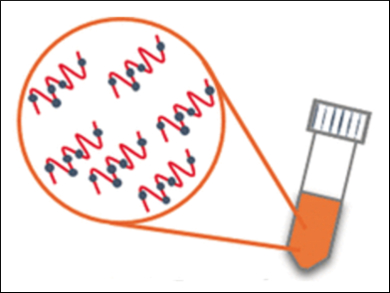Food Authentication with the Naked Eye
Is the food on the shelf really that what is written on the label? Its DNA would give it away, but the DNA barcoding technology, which can be used for this purpose, is labor-intensive. In the journal Angewandte Chemie, Italian scientists have introduced a simplified assay called NanoTracer. Combining DNA barcoding with nanotechnology, it requires neither expensive tools nor extremely skilled personnel, but just the naked eye to identify a color change.
The DNA barcoding technology identifies an organism by a short unique DNA sequence, the “barcode”. This barcode used for animal species—and thus for meat products—is the sequence of a gene of mitochondria, which are cell organelles. Its sequence tells the examiner if the product on the shelf contains exactly the species that is declared on the label, not a substituted or a diluted one. However, DNA barcoding requires elaborate procedures and takes time. Therefore, Pier Paolo Pompa, Italian Institute of Technology IIT, Genoa, and colleagues have developed a much simpler version of the test which requires fewer and cheaper reagents, scarce instrumentation, and features a simple color change as its output.
Gold Nanoparticles Cause Color Change
Its main concept is the reduction of the long barcode regions to short subregions, in which the species nevertheless show enough divergence. Shorter sequences have the advantage that even DNA can be identified that is no longer intact—as it happens in finished foods. The short sequences are then amplified by a polymerase chain reaction process. This step includes the second innovation. The researchers explain: “Our assay includes a universal sequence, which serves to prime the aggregation of (universal) DNA-functionalized gold nanoparticles, with consequent red-to-violet color change.” Or, in other words, if the sample DNA sequence matches that of the simplified barcode primers, the respective DNA segment is amplified, and the added nanogold agent aggregates, turning the test solution’s color from red to violet.
Using their assay, the scientists tested European perch, which is often substituted by cheaper fish species, and saffron powder, a high-value spice, which is frequently diluted with other herbs for economic gain. Both products were distinctly identified with NanoTracer, and the presence of substitutes or cheaper diluents was detected. As the researchers point out, their simplified assay is fast (it takes less than three hours) and sensitive, uses raw food material, involves simple low-cost technology and materials, and thus can be performed in decentralized simple laboratories at low cost.
- DNA Barcoding Meets Nanotechnology: Development of a Universal Colorimetric Test for Food Authentication,
Paola Valentini, Andrea Galimberti, Valerio Mezzasalma, Fabrizio De Mattia, Maurizio Casiraghi, Massimo Labra, Pier Paolo Pompa,
Angew. Chem. Int. Ed. 2017.
DOI: 10.1002/anie.201702120



